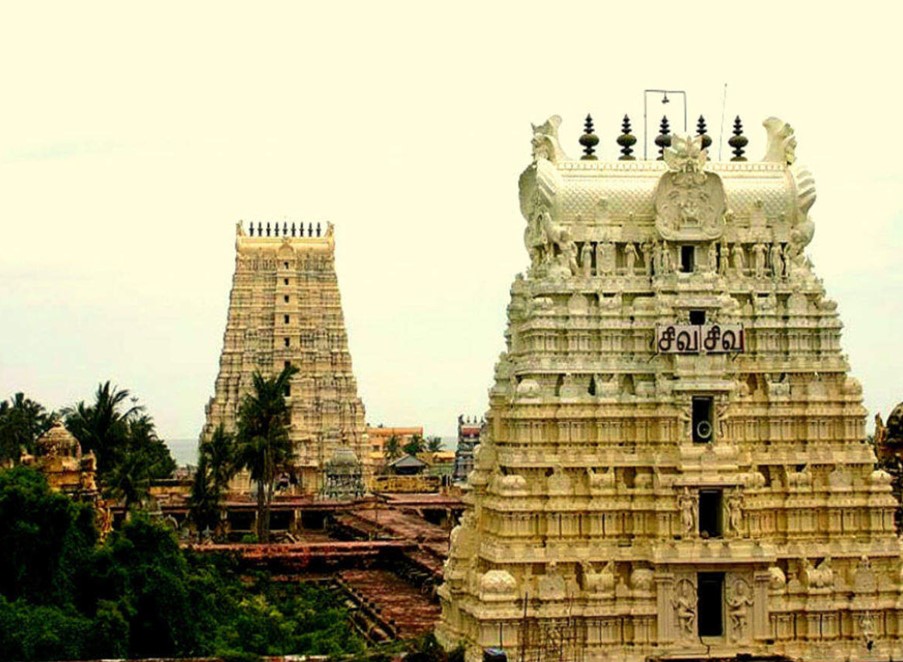Ramanathaswamy Temple
The Ramanathaswamy Temple is at Rameshwaram, Tamil Nadu, in southern India. Rameshwaram is a necessary stop on every pilgrimage to Banaras. The Pandya Dynasty built the current Ramanathaswamy Temple in the 12th century. The 1000-pillar hallway of the Ramanathaswamy Temple is a notable feature.

Origin of Ramanathaswamy Temple
The temple was originally merely a brick and thatch building, and it took centuries to develop into the majestic masterpiece it is today. The Chola monarchs constructed the area’s first stone temple in the 12th century, and Pandya and Vijayanagar kings later added to it. After taking control of Lanka, the mighty Krishna Deva Raya of Vijayanagar arrived here in 1513 and presented the temple with beautiful presents. The Sethupati rulers of Ramnad became the caretakers of the temple under the rule of the Nayakas, and they ultimately completed the temple. It is regarded as one of the best representations of Dravidian architecture today.
Deity
The main deity at the temple, Ramanathaswamy or Shiva, is represented by a lingam. The two Lingams that make up the temple’s sanctuary are the Ramalingam, which Sita constructed out of the sand, and the Vishwalingam, which Hanuman carried from Kailash.
Legendary Association
Ramanathaswamy, which alludes to Lord Shiva, is correctly translated as “The Master of Rama.” The temple is said to have been constructed by Lord Rama, a manifestation of the god Vishnu, who is there to repent for Sri Lankans’ misdeeds.
History behind the Temple
According to tradition, Rama desired a large Lingam to worship Shiva and atone for his guilt of murdering a Brahmin. He thus ordered Hanuman, his monkey lieutenant, the command to bring a Lingam from the Himalayas. Hanuman, however, took longer than anticipated to retrieve the Lingam. Rama’s wife, Devi Sita, was comforted by the incident and used the sand on the shore to construct a little Lingam. As a result, Lord Rama then erected the Lingam.
Architecture
The Ramanathaswamy Temple’s precinct consists of three enclosures, several tall gopuram entrances, numerous lesser shrines, holy ponds, and gardens. Shiva and the goddess Parvati, also known as Parvathavardhini Amman, each have their shrine. The wide hallway that encircles the shrine is renowned for being extremely magnificent. With 1240 meters, it is one of the longest in the nation and is by 1212 deftly carved pillars, marble statues of patrons, and an exquisitely painted ceiling.
Corridors
According to legend, the outer set of Ramanathaswamy temple corridors, which measure about 6.9 m in height, 400 feet in length in each direction (east and west), and about 640 feet in each order (north and south), is the longest corridor in the world.
Pillars
The outside corridor has roughly 1212 pillars. They stand about 30 feet tall from the bottom to the apex of the roof. The central tower, known as the Rajagopuram, is 53 meters tall. The majority of pillars have unique compositions etched into them.
Wells and Shrines
The 22 teerthams, or sacred water bodies in the shape of tanks and wells, are also inside the temple complex. These teerthams stand for Rama’s quiver of 22 arrows. Every devotee has to take a bath before entering the sanctum sanctorum. In the mandaps of the temple complex, there are a few minor shrines for different deities. The 22 wells have rumors of therapeutic qualities; each has a unique temperature, salinity, and flavor.
Significance
The Indian Ocean and the Bay of Bengal encircle Rameshwaram town. The town has special significance to Hindus as one of the four sacred Char Dhams, or places of devotion, that every Hindu has to visit once in their lifetime. The Ramanathaswamy Temple is a well-known Shaivite and Vaishnavite temple of devotion. The three most renowned Nayanars, Appar, Sundarar, and Tirugnana Sambandar, have honored the temple with their music at one of the 227 Paadal Petra Sthalams.
Final Thoughts
Isn’t this temple a gem? There is one thing a visitor should mind regarding the dress code to make sure the temple visit is peaceful. Visitors must adhere to stringent clothing requirements, particularly males who can enter the temple in vests and shirts. It is okay to wear cotton pants and shirts, but not jeans and t-shirts. With damp clothes on, people cannot enter the temple premises. Otherwise, this is an excellent place that you’ll always be proud of visiting.
